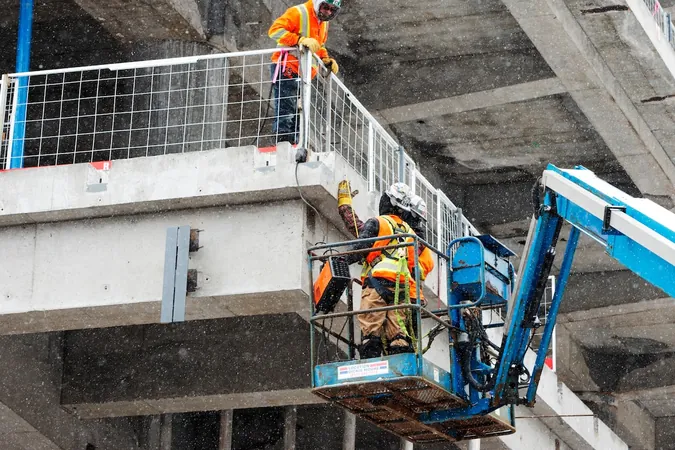
Looming Labour Crisis: Trucking and Construction Sectors Prepare for New Temporary Worker Regulations
2024-11-04
Author: Jacob
Overview of the New Regulations
As new regulations governing high-wage temporary foreign workers come into effect, some sectors in Canada, particularly trucking and construction, are bracing themselves for a potential labour crisis. Dominique Lamothe, the Human Resources Director at Groupe Nadeau, a significant trucking company based in Quebec, expressed deep concerns about the changes set to take place this Friday.
Impact on Trucking Industry
Groupe Nadeau operates a fleet of approximately 200 trucks and 1,400 trailers, relying on 70 full-time heavy mechanics—many of whom are temporary foreign workers. Previously, these workers were hired under a high-wage stream that allowed employers to recruit readily from abroad if they met a median wage threshold. However, with the recent announcement from Employment Minister Randy Boissonnault, the income cap for the high-wage stream has been lifted to 20% above the provincial median income, leading to a raise of $5 to $8 per hour on average.
Unemployment and Job Transition
As Canadian unemployment climbed to 6.5%, this shift in policy means that around 34,000 jobs will transition from the high-wage stream to stricter low-wage stream regulations, significantly affecting sectors where unemployment exceeds 6%. Lamothe warned, “We will not be able to renew all these work contracts because of this new law. This could mean losing 35 mechanics in our shop.”
Skill Gap in Local Recruitment
One of the critical challenges Groupe Nadeau faces is the inability to locally recruit skilled mechanics. Lamothe says that while they are actively reviewing applications, there is a noticeable skill gap. Many applicants do not match the necessary qualifications, and the added constraint of Quebec’s immigration policies—which require French proficiency for permanent residency—makes it all the more complicated.
Increase in Temporary Worker Approvals
The transportation sector has seen a remarkable increase in the number of approved assessments for temporary workers, which surged over 100% since 2020. Last year alone, approvals reached 11,106, up from just 5,495. Similarly, the construction industry has experienced a steep rise in temporary worker approvals, skyrocketing from 4,565 in 2020 to 15,360 in 2023, many of which were also categorized under the high-wage stream.
Current Labour Crisis in Construction
Rodrigue Gilbert, president of the Canadian Construction Association, voiced his concerns regarding the perceived easing of the labour shortage. “We still have a notable labour crisis in construction, with approximately 45,000 vacancies right now,” he stated, emphasizing that employment gaps are present across all job levels—ranging from entry-level positions to trades and management roles.
Government's Response and New Strategies
The government maintains that these regulatory changes aim to incentivize employers to hire individuals already residing in Canada, emphasizing that there are ample job seekers in the country. “We cannot allow the temporary foreign worker program to be a fallback option that undermines Canadian wages and overlooks local talent,” said Boissonnault during a recent press briefing.
Challenges in Meeting Qualifications
However, Gilbert pointed out the nuances involved in filling these construction roles. “While Immigration Canada claims to have brought in 50,000 permanent residents with construction experience between 2019 and 2024, actual qualification standards differ significantly,” he remarked. Achieving Red Seal certification—a national recognition of trade proficiency—can be a substantial hurdle for many foreign tradespeople.
Future Developments and Proposals
As these regulatory changes unfold, the government is poised for further alterations, potentially establishing more barriers for businesses applying for temporary worker assessments if the inflow of workers does not diminish as expected. Boissonnault hinted at raising application fees, currently set at $1,000 per position, as a strategy to control temporary worker numbers.
Conclusion: A Looming Workforce Emergency
Amidst these sweeping changes, Commissioner Ratna Omidvar has put forth proposals targeting the reform of the temporary worker program to mitigate abuses, suggesting a need for better oversight and improved coordination between employers, workers, and the government.
As the trucking and construction industries navigate the impending fallout from these new rules, stakeholders are left questioning the viability of sustaining their operations without the crucial support of temporary foreign workers. The looming labour crisis may soon escalate into a full-blown workforce emergency unless solutions are swiftly implemented.









 Brasil (PT)
Brasil (PT)
 Canada (EN)
Canada (EN)
 Chile (ES)
Chile (ES)
 España (ES)
España (ES)
 France (FR)
France (FR)
 Hong Kong (EN)
Hong Kong (EN)
 Italia (IT)
Italia (IT)
 日本 (JA)
日本 (JA)
 Magyarország (HU)
Magyarország (HU)
 Norge (NO)
Norge (NO)
 Polska (PL)
Polska (PL)
 Schweiz (DE)
Schweiz (DE)
 Singapore (EN)
Singapore (EN)
 Sverige (SV)
Sverige (SV)
 Suomi (FI)
Suomi (FI)
 Türkiye (TR)
Türkiye (TR)